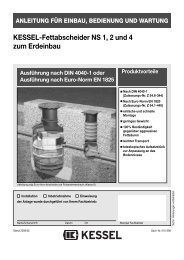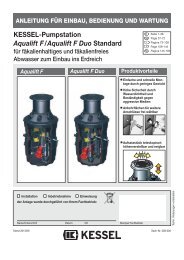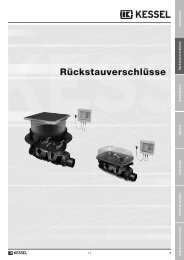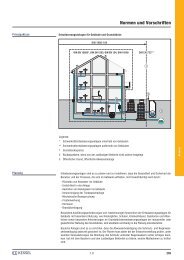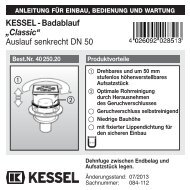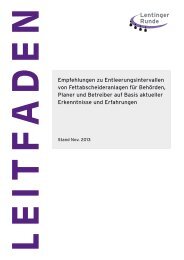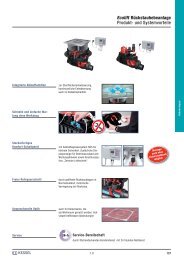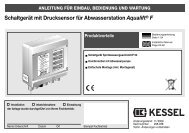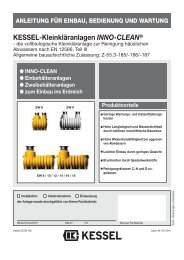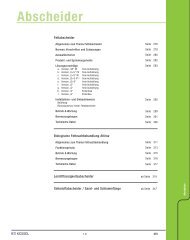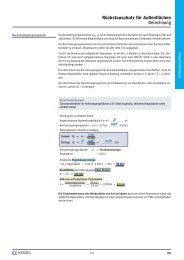KESSEL - Leichtflüssigkeitsabscheider
KESSEL - Leichtflüssigkeitsabscheider
KESSEL - Leichtflüssigkeitsabscheider
Erfolgreiche ePaper selbst erstellen
Machen Sie aus Ihren PDF Publikationen ein blätterbares Flipbook mit unserer einzigartigen Google optimierten e-Paper Software.
6. Commissioning<br />
The chapter "Safety instructions" must be heeded.<br />
6.1 Setting up for operation<br />
Before the separator is put into operation, please make sure<br />
that:<br />
the separator is clean and the interior is free from any objects<br />
which may have been placed inside during shipping<br />
or installation.<br />
the separator is completely filled with clean cold water.<br />
Completely filling the separator is complete when water<br />
begins to drain from the outlet.<br />
6.2 Initial Instructions<br />
Placing the separator into full operation is normally handled<br />
by a licensed tradesman although upon request can be handled<br />
by a <strong>KESSEL</strong> representative.<br />
The following personnel should be on hand when the initial<br />
instructions for placing the separator into operation are given:<br />
Building facilities manager<br />
Building maintenance workers<br />
Contracted plumber / tradesman<br />
Contracted disposal company<br />
What to do:<br />
Check to make sure the separator is completely watertight.<br />
Check to make sure that during transport and<br />
installation that no damage to the separator was<br />
caused. Check to make sure all connections to the<br />
separator (inlet, outlet, refill, rinse pipes etc.) are in<br />
perfect working order.<br />
Representative should discuss all necessary information<br />
regarding the disposal.<br />
Representative should take the customer step by step<br />
through all stages of a separator disposal.<br />
After the separator has been emptied (disposed) all<br />
necessary paperwork and documentation should be<br />
handed over to the customer.<br />
The separator should be returned to service by filling<br />
the separator with fresh, cold water.<br />
6.4 Hand-over of installation and user’s manual.<br />
6.5 Completion of the commissioning report.<br />
After commissioning has been completed the separator<br />
should be placed into normal operation mode.<br />
6.3 Commissioning report (see attachment)<br />
7. Disposal<br />
Disposal intervals:<br />
The fuel / oil collected in the separator should be collected /<br />
disposed when the level has reached 80% of the maximum<br />
storage capacity. Disposal of collected sludge in the base of<br />
the separator should be collected / disposed when the level<br />
has reached 50% of the maximum sludge storage capacity.<br />
Important: Timely disposal of the separator is mandatory to<br />
insure proper function and operation of the separator.<br />
A licensed disposal company should be contracted to handle<br />
disposal of the separator. Disposal should take place when<br />
little or no wastewater is entering the separator.<br />
Emptying intervals:<br />
The light fluid retained in the separator must be removed at the<br />
latest when the quantity of separated light fluid reaches 80% of<br />
the maximum storage quantity, or the level is below the retained<br />
volume. For separators simultaneously or exclusively used<br />
for the drainage of systems or areas where light fluids are handled<br />
(e.g. fuelling areas), the retained volume required under<br />
state regulations must also be provided. The separated light<br />
fluid must also be removed at levels below this retained volume<br />
if the quantity of separated light fluids has not yet reached<br />
80 % of the maximum storage quantity.<br />
The disposal of the sludge contained in the sludge trap must<br />
be removed at the latest when the separated sludge quantity<br />
reaches half of the sludge trap volume.<br />
Note: Light fluids and sludge must be removed as specified<br />
above in order to ensure the correct operation of the system.<br />
For this reason, a disposal contract should be concluded with<br />
a specialist disposal company. The disposal work should be<br />
carried out if possible when the system is not in operation.<br />
Expected disposal volumes in accordance with the filling level<br />
can be estimated by means of the following table.<br />
The figures contained in the table are approximate figures only<br />
for the purposes of estimating quantities when contracting a<br />
specialist disposal company.<br />
40



